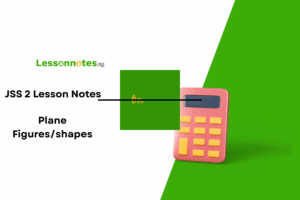Surds SS2 Mathematics Lesson Note
Download Lesson NoteTopic: Surds
RULES OF SURDS
Surds are irrational numbers. They are the root of rational numbers whose value cannot be expressed as exact fractions. Examples of surds are: √2, √7, √12, √18, etc.
- √(a X b ) = √a X √ b
- √(a / b ) = √a / √b
- √(a + b ) ≠ √a + √b
- √(a – b ) ≠ √a – √b
BASIC FORMS OF SURDS
√a is said to be in its basic form if A does not have a factor that is a perfect square. E.g. √6, √5, √3, √2 etc. √18 is not in its basic form because it can be broken into √ (9×2) = 3√2. Hence 3√2 is now in its basic form.
SIMILAR SURDS
Surds are similar if their irrational part contains the same numerals e.g.
- 3√n and 5√n
- 6√2 and 7√2
Conjugate Surds
Conjugate surds are two surds whose product result is a rational number.
(i)The conjugate of √3 – √5 is √3 + √5
The conjugate of -2√7 + √3 is 2√7 – √3
In general, the conjugate of √x + √y is √x – √y
The conjugate of √x – √y = √x + √y
SIMPLIFICATION OF SURDS
Surds can be simplified either in the basic form or as a single surd.
Example 1
Simplify the following in its basic form (a) √45 (b) √98
Solution
(a) √45 = √ (9 x 5) = √9 x √5 = 3√5
(b) √98 = √ (49 x 2) = √49 x √2 = 7√2
Example 2
Simplify the following as a single surd (a) 2√5 (b) 17√2
Solution
(a) 2√5 = √4 x √5 = √ (4 x 5) = √20
(b) 17√2 = √289 x √2 = √ (289 x 2) = √578
ADDITION AND SUBTRACTION OF SURDS
Surds in their basic forms which are similar can be added or subtracted.
Examples
Evaluate the following
(a)√32 + 3√8 (b) 7√3 – √75 (c) 3√48 – √75 + 2√12
Solution
(√32 + 3√8
= √ (16 x 2) + 3√ (4 x 2)
=4√2 + 6√2
= 10√2
(b) 7√3 – √75
= 7√3 – √ (25 x 3)
=7√3 – 5√3 =2√2
(c) 3√48 – √75 + 2√12
= 3√ (16 x 3) – √ (25 x 3) + 2√ (4 x
d) = 12√3 – 5√3 + 4√3
= 11√3
MULTIPLICATION AND DIVISION OF SURDS
Example: Evaluate the following:
(a) √45 x √28 (b) √24 /√50
Solution
(a) √45 x √28
= √ (9 x 5) x √ (4 x 7)
= 3√5 x 2√7
= 3 x 2 x √ (5 x 7)
= 6√35
(b)√24 / √50
= √ (24 / 50)
= √ (12 / 25)
= √12 / √25
= √ (4 x 3) / 5
= 2√3 / 5
SURDS RATIONALISATION
Rationalisation of surds means multiplying the numerator and denominator by the denominator or by the conjugate of the denominator.
Example: Evaluate the following
(a) 6/√3 (b) 3 ÷ √3 + √2
Solution
- a) 6/√3
= 6 x √3
√3 x √3
= 6√3
3
= 2√3
(b) 3√3 + √2
= 3 (√3 – √2)
(√3 + √2) (√3 – √2)
= 3√3 – 3√2
(√3)2 – (√2)2
= 3√3 – 3√2
3 – 1
= 3√3 – 3√2
1
= 3(√3 -√2)
EQUALITY OF SURDS
Given two surds i.e P + √m and q + √n if P +√m = q + √n then
√P – q = √n – m the L.H.S
The equation is a rational number while the L.H.S and R.H.S can only be equal if they are both equal to zero (0)
P – q = 0
:. P = q and n – m = 0 i.e.
√n = √m
Examples:
Find the square root of the following?
- a) 7 + 2√10 b) 14 – 4√6
Solution
(a) Let the square root of 7 + 2 √10 be √m + √n
(√m + √n)2 = 7 + 2√10
m +√2mn+ n = 7 + 2√10
m + n = 7 (1)
2√mn = 2√10
mn = 10
Squaring both surds we have
mn = 10 _______(ii)
m + n = 7 ______ (i)
m n = 10 _______ (ii)
From equation (1) m = 7 – n
Put m in (ii) we have
(7 – n) n = 10
7n – n2 = 10
In sum; n2 – 7n + 10 = 0
n2 – 2n – 5n + 10 =0
n (n – 2) – 5 (n – 2) = 0
(n -5) (n – 2) = 0
n = 5 or 2
m = 7 – 2, where n = 2
m = 5,
m = 7 – 5, when n = 5
m = 2
m= 5 or 2
The square root of 7 + √10 is 5 & + 2.
(b) Let the square root of 14 – 4√6 be √P – √Q
The (√P – √Q) 2 =14 – 4√6
P – 2√PQ + Q = 14 – 4 √6
P + Q = 14 …………………… (1)
-2√PQ = – 4√6
-2 – 2
√PQ = 2√6 (squaring both sides)
PQ = (2√6)^2
PQ = 4 x 6 ……………………………….. (11)
P + Q = 14 ………………………………… (1)
PQ = 24 ……………………………………… (11)
From equation……………… (1) P = 14 – Q
Sub for p in equation ………………… (11)
(14 – Q) Q = 24
14Q – Q^2 = 24
In turn, we have:
Q^2 – 14Q + 24 = 0
Q^2 – 12Q – 2Q + 24 = 0
Q (Q -12) – 2 (Q – 12) = 0
Q = 2 or 12
If P = 14 – Q, when Q= 12
P = 14 – 12
P = 2
If P = 14 – Q when Q = 2
P = 14 – 2
= 12
(√12 – √2 ) = (2 √ 3 – √2) and
(√2 – √12) = (√2 – 2 √3)
ASSIGNMENT
- Expand (3√2 – 1) (3√2 + 1) (a) 16 (b) 20 (c) 17 (d) 24
- Simplify √200 in its basic form (a) 10√2 (b) 5√4 (c) 2√10 (d) 2√50
- Simplify 9/√3 (a) 3√2 (b) 3√3 (c) 1/3 (d) 2√2
- Express 3√5 as a single surd (a) √40. (b) √55 (c) √45 (d) √35
- Simplify √`128 – 4√8 (a) 0 (b) 1 (c) 2 (d) 3
- Express 3√2 – √3
2√3 – √2 in the form √m/√n where m and n are whole numbers.
7. Express. 1
√5 +√3 in the form p√5 + q√3, where p and q are rational numbers.






















